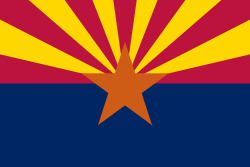Arizona is a southwestern U.S. state that shares borders with four U.S. states and two Mexican states. The state encompasses 113,998 square miles of diverse terrain, from arid deserts to pine forests, making it the 6th largest state in America.
Geography Shapes Arizona’s Identity
The Grand Canyon, carved by the Colorado River over millions of years, stands as Arizona’s most iconic landmark. This natural wonder stretches 277 miles long and plunges more than a mile deep. The state’s landscape varies dramatically from the southern desert Basin and Range region to the northern Colorado Plateau’s pine-covered highlands.
Climate Creates Distinct Regions
Southern Arizona experiences scorching summers with temperatures reaching 120°F, while the northern regions enjoy milder conditions. The state’s record high of 128°F occurred at Lake Havasu City, contrasting with a record low of -40°F at Hawley Lake. Annual rainfall averages 12.7 inches, arriving through winter storms and summer monsoons.
Population Centers Define Modern Arizona
Phoenix, the state capital, leads as Arizona’s largest metropolitan area with 4.7 million residents. Tucson follows as the second-largest city, home to one million people and the University of Arizona. The state’s population reached 7.1 million in 2020, showing an 11.9% growth since 2010.
Cultural Diversity Enriches Communities
Native American tribes, including the Navajo Nation, occupy about one-quarter of Arizona’s land. Hispanic communities have grown significantly since the 1980s, while the state also hosts substantial populations of Mormon and Catholic followers.
Economic Evolution
Arizona’s economy transformed from the traditional “five C’s” (copper, cotton, cattle, citrus, and climate) to a diverse mix of industries. The state’s gross product reached $508 billion in 2023, with healthcare, transportation, and government leading the sectors.
Transportation Networks Connect Communities
Interstate highways I-17, I-19, I-8, I-10, and I-40 link Arizona’s cities. The Valley Metro Rail serves the Phoenix area, while Amtrak‘s Southwest Chief route connects northern communities.
Historical Milestones
Arizona joined the Union on February 14, 1912, as the 48th state. The territory previously belonged to Mexico until the 1848 Treaty of Guadalupe Hidalgo and the 1853 Gadsden Purchase transferred it to the United States. The state played significant roles in World War II, hosting POW camps and Japanese American internment facilities.
Citations:
https://en.wikipedia.org/wiki/Culture_of_Arizona
Arizona (/ˌærɪˈzoʊnə/ ARR-iz-OH-nə; Navajo: Hoozdo Hahoodzo [hoː˥z̥to˩ ha˩hoː˩tso˩]; O'odham: Alĭ ṣonak [ˈaɭi̥ ˈʂɔnak]) is a state in the Southwestern region of the United States, sharing the Four Corners region of the western United States with Colorado, New Mexico, and Utah. Its other neighboring states are Nevada to the northwest and California to the west. It also shares an international border with the Mexican states of Sonora and Baja California to the south and southwest. It is the 6th-largest and the 14th-most-populous of the 50 states. Its capital and largest city is Phoenix, which is the most populous state capital in the United States.
Arizona is the 48th state and last of the contiguous states to be admitted to the Union, achieving statehood on February 14, 1912. Historically part of the territory of Alta California and Nuevo México in New Spain, it became part of independent Mexico in 1821. After being defeated in the Mexican–American War, Mexico ceded much of this territory to the United States in 1848, where the area became part of the territory of New Mexico. The southernmost portion of the state was acquired in 1853 through the Gadsden Purchase.
Southern Arizona is known for its desert climate, with very hot summers and mild winters. Northern Arizona features forests of pine, Douglas fir, and spruce trees; the Colorado Plateau; mountain ranges (such as the San Francisco Mountains); as well as large, deep canyons, with much more moderate summer temperatures and significant winter snowfalls. There are ski resorts in the areas of Flagstaff, Sunrise, and Tucson. In addition to the internationally known Grand Canyon National Park, which is one of the world's seven natural wonders, there are several national forests, national parks, and national monuments.
Arizona is home to a diverse population. About one-quarter of the state is made up of Indian reservations that serve as the home of 27 federally recognized Native American tribes, including the Navajo Nation, the largest in the state and the country, with more than 300,000 citizens. Since the 1980s, the proportion of Hispanics has grown significantly owing to migration from Mexico and Central America. A substantial portion of the population are followers of the Roman Catholic Church and the Church of Jesus Christ of Latter-day Saints. Arizona's population and economy have grown dramatically since the 1950s because of inward migration, and the state is now a major hub of the Sun Belt. Cities such as Phoenix and Tucson have developed large, sprawling suburban areas. Many large companies, such as PetSmart and Circle K, have headquarters in the state, and Arizona is home to major universities, including the University of Arizona, Arizona State University, and Northern Arizona University. The state is known for a history of conservative politicians such as Barry Goldwater and John McCain, though it has become a swing state in recent years.








